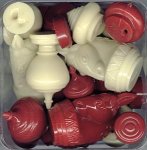Ouk Chatrang, Cambodian Chess
and Makruk, Thai Chess
Ok or Ouk Chatrang is Cambodian Chess, Chess played in Cambodia and Makruk is Thai or Siamese Chess, Chess played in Thailand (old name was Siam).
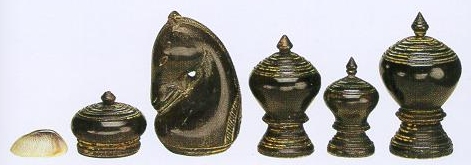
A
traditional set (Scan from Gareth
Williams, "Master Pieces", Apple Press, London, 2000)
Both national varieties are in fact almost the same game. Makruk is now one of the better recognized Chess variety. It is a very lively game, played in Thailand.
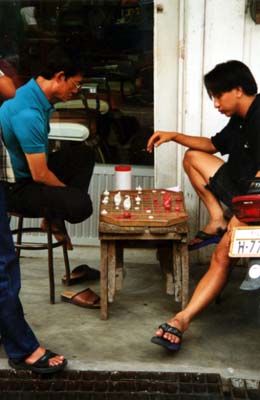
Makruk is also widely played in Cambodia as attested by Tim Krabbé. It is the true form of Cambodian Chess: the form given by Gollon and Pritchard (1st edition) in their books is, most probably, an invention. See the dedicated page to this strange Cambodian Chess.
In a very important article, Ouk Chatrang, the true Cambodian Chess, is described in detail by Vuthy Tan. However, his page is becoming old (June 13, 1998) and its disparition can be feared. Therefore, it has been decided to offer here a mirror for this precious page: Mirror page: Cambodian Chess Games by Vuthy Tan. (Disparition has finally happened!).
A page from the Khmer Institute offers a reliable information. See here. Nice photographs are shown here.
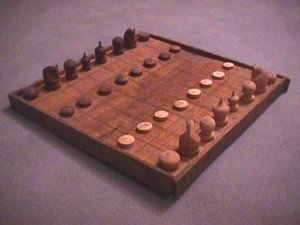
Wooden
set used in Cambodia (Photograph by Tim Krabbé)
SHORT DESCRIPTION:
The name of the pieces and their meanings are the following:
|
|
Cambodian |
Thai |
|
King |
Sdaach, Ang (King) |
Khun (Lord) |
|
Queen |
Neang (Maiden) |
Met (Seed*) |
|
Bishop |
Koul (Pillar) |
Khon (Nobleman) |
|
Knight |
Ses (Horse) |
Ma (Horse) |
|
Rook |
Tuuk (Boat) |
Rua (Boat) |
|
Pawn |
Trey (Fish) |
Bia (Cowrie shell) |
* A seed is weird in this Chess context. The name could originate from the Sanskrit "Mantri" (=counsellor, minister) which was used in India as well as in Malaysia and Java.
The Queen is always placed at right of the King in the setup. Contrarily to European Chess, the King are not facing each other.
The King moves as in European Chess. In Cambodia, he is allowed to make a Knight jump at his first move. This special move is no more used in Thailand.
The Queen moves 1 step diagonally only, conserving the old Indo-Persian move. In Cambodia only, she can jump at the 2nd case straight ahead (e1-e3) at her first move.
The Bishop can step 1 case in the 4 diagonal directions as well as straight forward. This is commented below.
The Knight and the Rook moves exactly as their European counterpart.
The Pawn moves 1 step ahead and captures 1 step diagonally ahead as in European Chess. There is no initial double step allowed and no en-passant capture. The Pawns are small flat tokens or cowries which are flipped upside down when promoted. The promotion is for Queen only and is obtained when the Pawns reach the 6th row (the initial row of opposite Pawns).
The game is won when the opposite King is mate. Pat and isolated King (if all pieces have been taken) are drawn games.
Plastic set sold in Thailand

(Red
and white, photograph from James
Master)
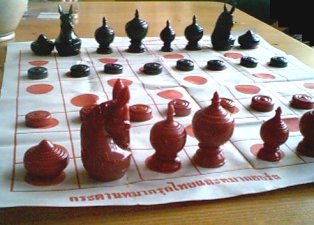
(Black
and red, photograph by Hans Bodlaender)
HISTORY :
The very first account of Siamese Chess is due to La Loubère, the ambassador of French King Louis XIV to the Kingdom of Siam in 1687-8. More will be given by the Captain James Low to Asiatic Researches in 1836 and, finally, Edward Falkener will supply reliable informations he had got from Prince Devawongsee, Minister of Foreign Affairs of H.M. the King of Siam, in 1889.
Ouk Chatrang is most probably played in Cambodia for a long time, as it is depicted in several reliefs found on the Angkor temples which date from the XIIth century.
Also, they were attested by Marco
Polo : in 1285, he went to "Cyamba" which is Champa, a
Kingdom located in South Vietnam. His book says : "Il
y a olifans assez en ce royaulme et si ont aussi lingaloes assez
et si ont moult grant planté de grans bois et si ont fust noir
que l'en appelle ybenus et dont l'en fait les eschiez noirs."
(There are elephants in this realm and they also have a lot of
aloe wood and they have black wood named ebony from which black
chess are made). Chinese chess which is used today in Vietnam
(Tuo-cong) did not used ebony pieces, then it is very likely that
Marco Polo saw a cousin of the Cambodian Chess.
(Thanks
to Thierry Depaulis for drawing my attention to this point)

Cambodian
Chess Set, ivory, early 20th c.
|
|
|
|
|
|
|
Ivory Chess Knight believed to be
a Viking piece! Apparently, this is a Makruk Knight |
Another Thai Knight |
DISCUSSION
In the 1st millennium AD, the Indian culture spreads into south-east Asia. Under the influence of Tamil spice traders coming from the South of India and Ceylon, especially under the Chola dynasty, several indianised kingdoms were founded like Srivijaya in Sumatra and Java, Champa in South Vietnam, Zhenla and other Khmer states in Cambodia, etc.. Magnificent temples in Borobudur (Java) or Angkor (Cambodia) are still there to remember. Indians brought Hinduism, Buddhism, Sanskrit and writing alphabets, and also Chaturanga : Chess.
The first kingdoms founded by the Khmer people, Funan, Zhenla, felt under Javan domination circa 700. Jayavarman II, a prince educated in Java founded the Angkor Khmer kingdom in 802. Then, it can be assumed that Chess came in Cambodia from Java which in turn held it from South-East Indians.

On
XIIth century, Khmer empire encompassed modern Thailand.
Thai people migrated from China in the Xth century, then founded several states. In 1431 they seized Angkor and assimilated the Khmer kingdom. They probably learnt Chess from Cambodians and this is the reason why Cambodian Chess and Thai Chess are so identical.
In 1913, the great Chess historian Murray confessed in his History of Chess: "It is not possible to discover any trace of Indian ancestry in the nomenclature of Siamese Chess". However, today it is known that "Mak" is the word used for games in Thai and "Ruk" could come from Cambodian "ruk" or "ouk" meaning Check or Chess. Then "Makruk" would simply be "The Chess game". (from a private discussion with Th. Depaulis).
This South-East Asian Chess is probably the closest to the original Chess which comes from India. It has several similarities with the Sittuyin played in Burma but the latter seems more elaborated. In Malaysia and Indonesia, Chess (Main Chator) was latter influenced by Europeans -Portuguese, Dutch and English- and therefore, has lost some original rules and characteristics (for instance, they adopted the modern move of Queen and Bishop).
There are several points which merit a discussion :
The bulky shape of the piece is apparently an old tradition since it can be seen on Angkor temples. Only the Horse has a recognizable form. A similar design is found on the set of Malay Chess shown in Murray's History of Chess. That reinforce the link between Cambodia and Malay/Java.
A Boat is used in place of the Rook. This is known to be common in India as well, especially in the South and in the East (Bengal) and also in Java according to Murray. (It is also the case in Russia but we think that the reason is different). Boats are attested for sure in Indian Chess since circa 1500. Replacing the Chariot by a Boat in the warfare for people trading and struggling onto the seas is something which can be easily understood. It reinforces the maritime arrival of Chess in this region.
The sense of Elephant (Bishop) is hidden both in the name and in the form of the piece. In battlefield, in troops parade, noblemen used to sit on the back of elephants. Also, one can say that elephants are the pillars of the fighting army.
More important is the move associated to this piece : it can step 1 case in the 4 diagonal directions as well as straight forward. This move was already attested by the Persian al-Beruni in India, his account of his trip in that country circa 1030. He said that these 5 directions were to remind the four feet and the trunk of the animal ! The original Elephant move which consisted in a diagonal leap on the 2nd square allowed to reach only 1/8 of the board. This genital weakness received several attentions in different regions in the world : the Korean gave their Elephant an elongated Knight move (see Changgi), the European invented our modern Bishop sometimes at the end of the Middle Ages. This 5-limb stepping, probably born in Buddhist centers according to H.J.R. Murray, is a third response.
The Pawns are in an advanced position, on the 3rd line. This was probably adopted to accelerate the original game which was slow. Again, it can be compared to other solutions made in other places like the Arab Ta'biyat in Shatranj or the initial phase (werera) in the Ethiopian Senterej.
The Pawns are either flat tokens or cowrie shell (having a slot on one face). They get their promotion when reaching the 6th row (the 3rd from the opponent's edge). Then, they are turned upside down to show that promotion.
The last 4 points can also be found in Shogi, the Japanese Chess. Modern Shogi historians now believe that Shogi has been influenced by Chess played in the South-East regions. There were frequented commercial maritime routes connecting Japan to India through the Malay Straits in these times.
Find the rules of Makruk, the Thai Chess, on chessvariants.com
There is a book about Makruk / Ouk Chatrang: "Thai Chess and Cambodian Chess, Makruk and Ouk Chatrang", Gary Gifford, Lulu Publishing, 2011
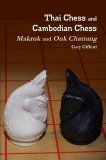
References:
Marco Polo, "La description du Monde" Le Livre de poche, Lettres gothiques, édition, traduction et présentation par Pierre-Yves Badel, 1998.
Bernd Ellinghoven, Christine Gruber, "Kambodschach, Work in Progress zur Geschichte des Schachspiels in Kambodscha" in Studiengemeinschaft Kambodschanische Kultur e.V., Schriftenreiche Heft Nr. 8, Berlin 2003.
(Thanks to Bernd Ellinghoven for sending precious information)






